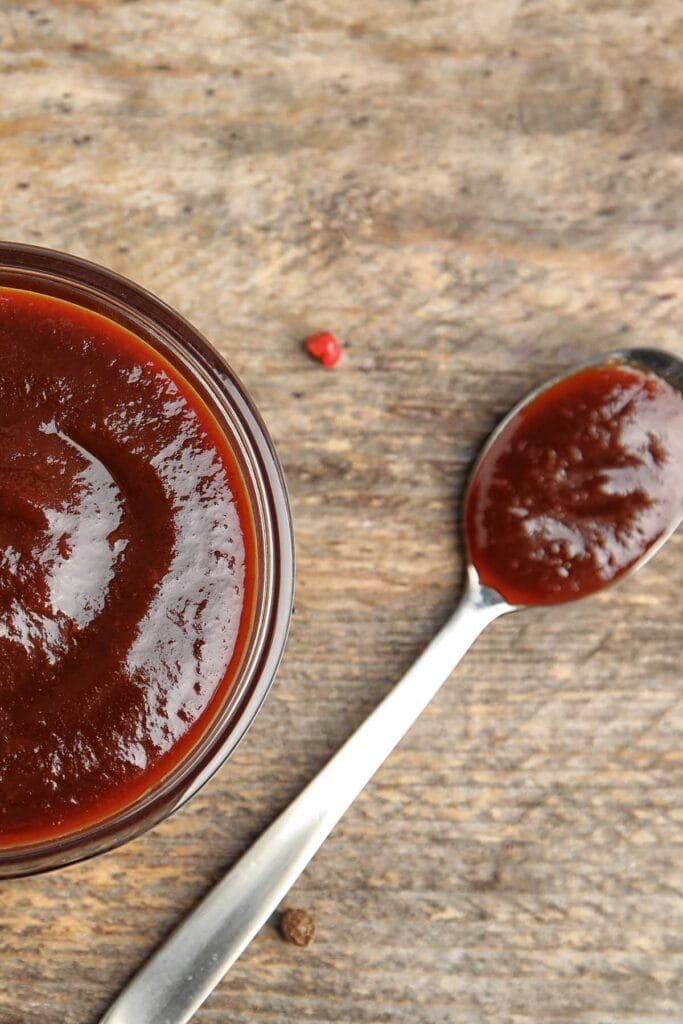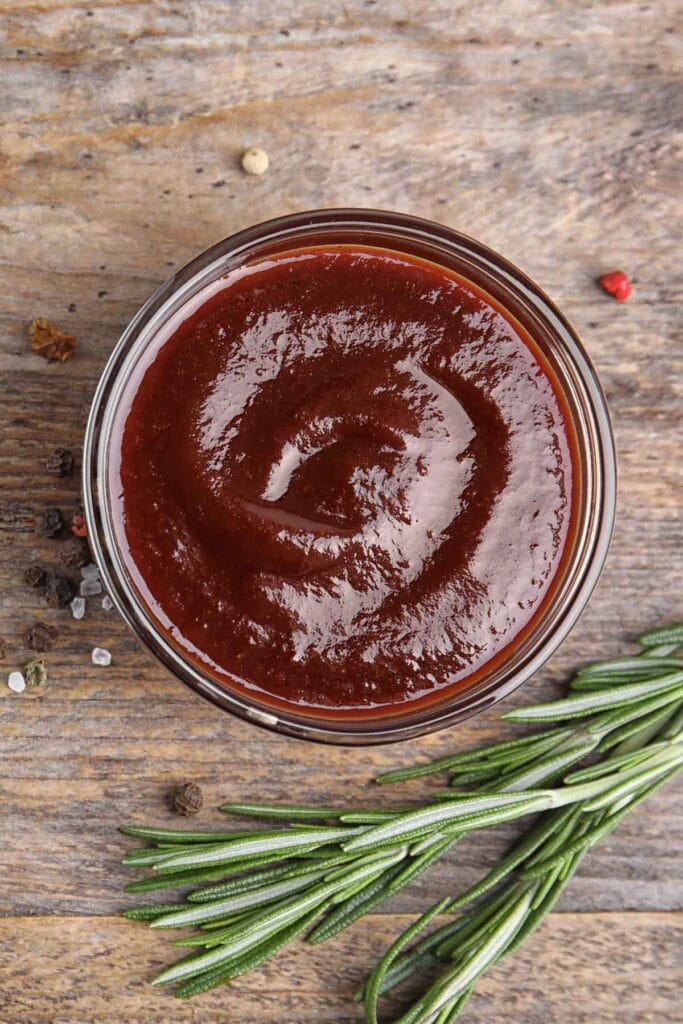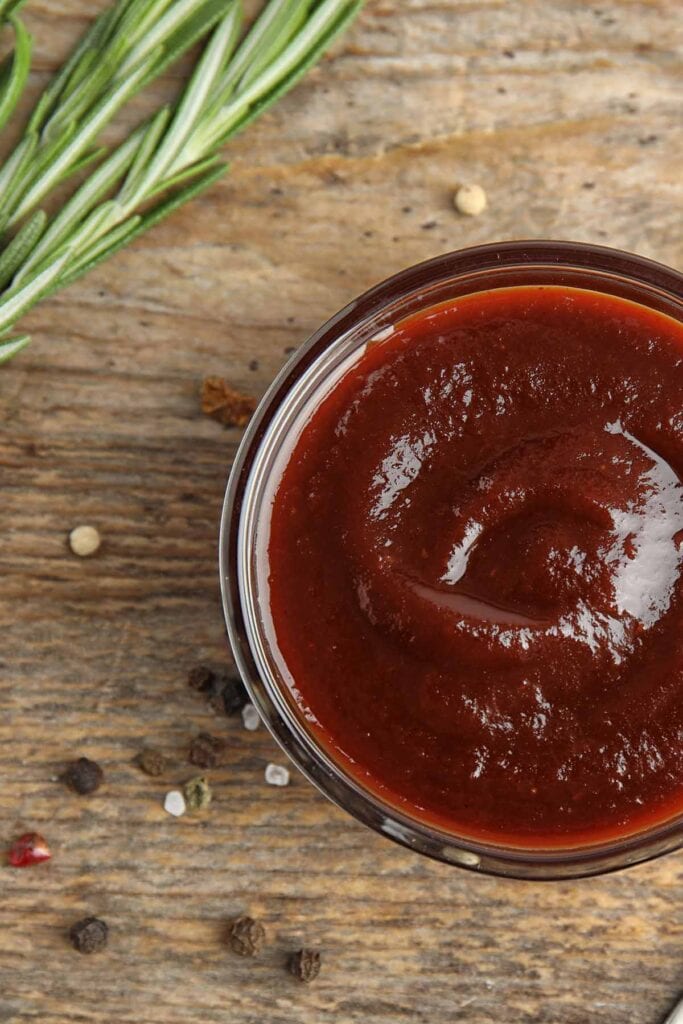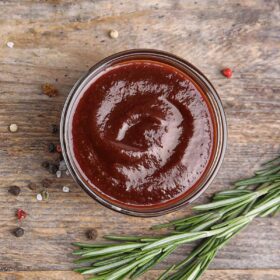This homemade Korean BBQ sauce is amazing thanks to its perfect balance of sweet, savory, and tangy flavors! It’s easy to make, budget-friendly and you can completely customize the ingredients to ensure a healthier spin on this delicious condiment.

I love a good homemade condiment. If you do too, you should try my tahini sauce, my easy peanut sauce and my pesto aioli!
Why you’ll love this recipe
- Fresh and preservative-free. Homemade sauces ensure you use fresh, natural ingredients, avoiding preservatives and artificial additives found in store-bought versions. This version is naturally vegan too.
- Endless versatility. Korean barbecue sauce enhances a wide range of dishes, from marinating seitan to drizzling over grilled vegetables or using as a dipping sauce.
- Easy and quick to make. With simple ingredients and a short prep time, whipping up this sauce at home is a breeze, adding an authentic Korean touch to your meals!
What is Korean BBQ sauce made of?
- Soy sauce or tamari. Provides the umami base and salty flavor that characterizes Korean BBQ sauce. If you’re watching your salt intake, you can use low-sodium soy sauce.
- Brown sugar. Adds sweetness to balance the savory and tangy elements in the sauce.
- Sesame oil. Infuses the sauce with a nutty aroma and deepens the overall flavor profile.
- Garlic. Enhances the sauce with a rich, aromatic taste that is a staple in Korean cuisine.
- Ginger. Adds a zesty and warm kick to the sauce, complementing the other flavors.
- Rice wine vinegar. Provides a mild tang that balances the sweetness of the sauce.
- Gochujang paste (Korean chili paste). Infuses the sauce with a spicy and slightly sweet taste, signature to Korean BBQ sauce. This can be found in the Asian section of most larger supermarkets, your local Asian grocery store, or online!
- Water. Helps to achieve the desired consistency and dilutes the strong flavors for a well-balanced sauce.
How to make Korean BBQ sauce
Step 1 – Combine sauce ingredients. In a small bowl, combine the soy sauce, brown sugar, sesame oil, minced garlic, grated ginger, rice vinegar, and gochujang. Whisk the mixture until the brown sugar dissolves, and all the ingredients are well combined.
FREE EBOOK SERIES! 5 SECRETS FOR FOOLPROOF VEGAN DESERTS
Step 2 – Dilute the mix. Add the water to the mixture, adjusting the consistency to your desired thickness. If you prefer a thicker sauce, you can omit or reduce the water.
Step 3 – Taste check. Taste the sauce and adjust the sweetness, spiciness, or tanginess to your liking. You can add more brown sugar for sweetness, gochujang for spiciness, or rice vinegar for tanginess. Your Korean BBQ sauce is now ready to use!

Tips to make the best recipe
- Use quality ingredients. Opt for high-quality soy sauce, sesame oil, and gochujang for an authentic and flavorful Korean BBQ sauce. Using fresh garlic and ginger will also enhance the taste.
- Marinate and baste. For tofu or seitan, allow the protein to marinate in the sauce for at least 30 minutes (or longer for richer flavors). During grilling, baste the vegetables with the sauce to create a delicious caramelized glaze.
- Customization. Feel free to get creative and tailor the sauce to your preferences. Add a splash of lime juice for extra tang, a drizzle of honey for added sweetness, or even a dash of Sriracha sauce and black pepper for more warmth.
Storage instructions
To store: Transfer any leftover sauce into an airtight container and refrigerate it promptly. Properly stored, the sauce can last for up to 1 to 2 weeks in the fridge.

Recommended tools
- Basting brush. This will help ensure that your sauce evenly coats your vegetables or proteins.
Use this sauce to enhance
Frequently asked questions
While gochujang provides the signature Korean flavor, you can substitute it with other chili pastes or hot sauces. However, keep in mind that the taste may vary, so adjust the quantity to your spice preference.
It’s recommended to store the sauce in the refrigerator to maintain its freshness and prevent spoilage. Avoid leaving it at room temperature for extended periods.
Absolutely! This versatile sauce can be used for stir-frying or sautéing vegetables, tofu, or even noodles to add Korean-inspired flavors to your dishes.
Unfortunately not, most soy sauces contain gluten.

Korean BBQ Sauce
Ingredients
- 1/4 cup soy sauce
- 2 tablespoons brown sugar
- 1 tablespoon sesame oil
- 3 cloves garlic minced
- 1 tablespoon fresh ginger grated
- 2 tablespoons rice vinegar
- 2 tablespoons gochujang or chili paste
- 2 tablespoons water
Instructions
- In a mixing bowl, combine the soy sauce, brown sugar, sesame oil, minced garlic, grated ginger, rice vinegar, and gochujang. Stir the mixture until the brown sugar dissolves, and all the ingredients are well combined.
- Add the water to the mixture, adjusting the consistency to your desired thickness. If you prefer a thicker sauce, you can omit or reduce the water.
- Taste the sauce and adjust the sweetness, spiciness, or tanginess to your liking. You can add more brown sugar for sweetness, gochujang for spiciness, or rice vinegar for tanginess. Your Korean BBQ sauce is now ready to use!
Talk Back To Me